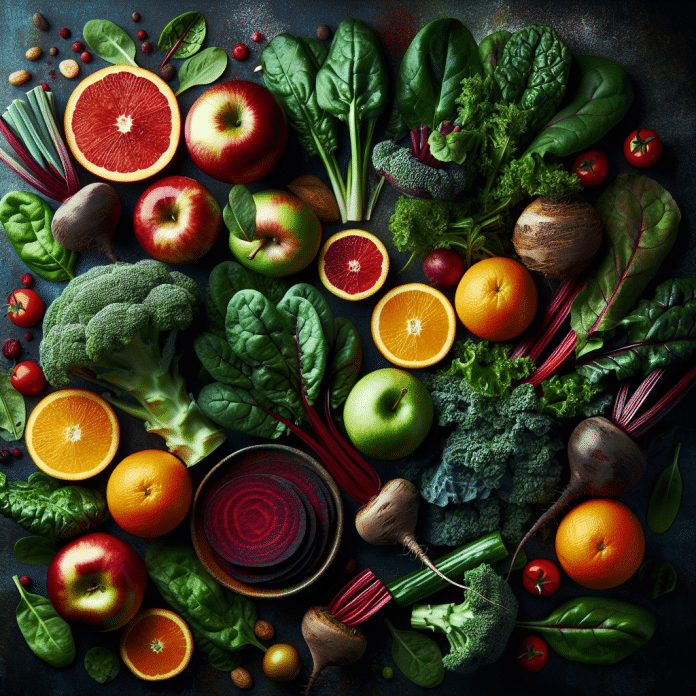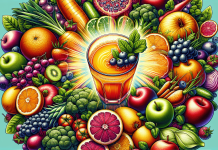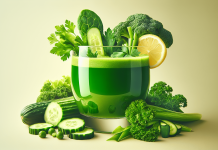Are you struggling with low iron levels and anemia? If so, you’ll be delighted to discover these juice recipes specifically designed to combat anemia and boost iron levels. Packed with powerful nutrients and vitamins, these refreshing and delicious juices can be easily incorporated into your daily routine to help improve your overall health and vitality. Say goodbye to fatigue and hello to a stronger, more energized you with these fantastic juice recipes.
Review contents
Types of Anemia and Iron Deficiency
Iron-Deficiency Anemia
Iron-deficiency anemia is the most common type of anemia, and it occurs when the body has a deficiency of iron. Iron is crucial for the production of hemoglobin, which is responsible for transporting oxygen to the body’s tissues. When there is not enough iron, the body is unable to produce enough hemoglobin, leading to a decrease in the number of healthy red blood cells. This can result in symptoms such as fatigue, weakness, pale skin, and shortness of breath.
Sickle Cell Anemia
Sickle cell anemia is a genetic condition that affects the shape of red blood cells. In this type of anemia, the red blood cells are crescent-shaped, resembling a sickle. These abnormal cells have a shorter lifespan and are more prone to getting stuck in blood vessels, causing blockages and reducing the oxygen supply to various organs. Sickle cell anemia can cause severe pain, organ damage, and an increased risk of infections.
Vitamin Deficiency Anemia
Vitamin deficiency anemia occurs when the body lacks essential vitamins, such as vitamin B12 or folate. These vitamins are important for the production of red blood cells. A deficiency in these vitamins can lead to a decrease in the number of red blood cells and cause anemia. Symptoms of vitamin deficiency anemia can include fatigue, weakness, shortness of breath, and pale skin.
Hemolytic Anemia
Hemolytic anemia is a type of anemia that occurs when there is an increased destruction of red blood cells. This can be caused by various factors, including certain medications, infections, autoimmune disorders, or inherited conditions. When red blood cells are destroyed faster than the body can replace them, it can lead to anemia. Symptoms of hemolytic anemia can include fatigue, jaundice (yellowing of the skin or eyes), and an enlarged spleen.
Importance of Iron for the Body
Role of Iron in the Body
Iron plays a vital role in various functions of the body. It is an essential component of hemoglobin, which is responsible for carrying oxygen from the lungs to the rest of the body. Iron also plays a crucial role in energy production, as it is involved in the production of adenosine triphosphate (ATP), the molecule responsible for storing and transferring energy within cells. Additionally, iron contributes to the normal functioning of the immune system, cognitive development, and overall growth.
Signs and Symptoms of Iron Deficiency
When the body lacks iron, it can lead to iron deficiency anemia. Some common signs and symptoms of iron deficiency include fatigue, weakness, pale skin, dizziness, shortness of breath, and a rapid or irregular heartbeat. Other symptoms may include brittle nails, hair loss, restless leg syndrome, and cravings for non-food items like ice or dirt. If you experience any of these symptoms, it is important to consult with a healthcare professional for proper diagnosis and treatment.
Causes of Iron Deficiency
Iron deficiency can occur due to a variety of reasons. Poor diet, especially one that lacks iron-rich foods, can contribute to iron deficiency. Some medical conditions, such as gastrointestinal disorders like celiac disease or Crohn’s disease, can interfere with iron absorption in the body. Women, especially those with heavy menstrual periods or pregnant women, are at a higher risk of iron deficiency due to increased iron needs. Blood loss from chronic conditions, such as ulcers or certain cancers, can also lead to iron deficiency.
Who is at Risk of Iron Deficiency
Certain groups of people are at a higher risk of iron deficiency. These include infants and young children, pregnant women, women with heavy menstrual periods, vegetarians and vegans who do not consume enough iron-rich plant-based foods, and individuals with certain medical conditions that affect iron absorption or cause chronic blood loss. It is important for these individuals to pay close attention to their iron intake and seek guidance from healthcare professionals.
Iron-Rich Fruits and Vegetables
Leafy Greens
Leafy green vegetables like spinach, kale, and Swiss chard are excellent sources of iron. These greens not only provide iron but also contain other beneficial nutrients like vitamin C and folate, which aid in iron absorption. Adding spinach or kale to your daily diet can help increase your iron intake and combat iron deficiency.
Citrus Fruits
Citrus fruits, such as oranges, lemons, and grapefruits, are not only refreshing but also rich sources of vitamin C. Vitamin C enhances iron absorption in the body and helps convert plant-based iron into a more absorbable form. Pairing citrus fruits with iron-rich foods can boost your body’s ability to absorb iron and improve your iron levels.
Berries
Berries like strawberries, raspberries, and blueberries are not only delicious but also packed with iron, folate, and vitamin C. These small but mighty fruits can be a great addition to your diet to increase iron intake. Enjoy them as a snack or add them to smoothies, yogurts, or salads for a nutrient-dense boost.
Dried Fruits
Dried fruits, such as apricots, raisins, and prunes, are concentrated sources of iron. They are portable and make for convenient and healthy snacks. Including a handful of dried fruits in your diet can provide a significant amount of iron and help combat iron deficiency.
Tomatoes
Tomatoes are not only a versatile ingredient in various dishes but also a surprising source of iron. They are rich in vitamins A and C, which support iron absorption. Incorporating tomatoes into your meals, whether as a sauce, salad ingredient, or topping, can contribute to your overall iron intake.
Beans and Legumes
Beans and legumes, such as lentils, chickpeas, and kidney beans, are excellent plant-based sources of iron. They are also high in protein, fiber, and other essential nutrients. Adding beans and legumes to your meals, whether in soups, stews, or salads, can provide a substantial amount of iron and help prevent and manage iron deficiency.
Juice Recipes for Anti-Anemia and Iron Boosting
1. Spinach and Citrus Juice
- Ingredients: a handful of spinach, 2 oranges, 1 lemon
- Directions: Juice the spinach, oranges, and lemon together. Serve it chilled and enjoy the refreshing taste and iron-boosting properties of this juice.
2. Beetroot and Carrot Juice
- Ingredients: 1 small beetroot, 2 carrots
- Directions: Juice the beetroot and carrots together. This vibrant and nutrient-packed juice is not only rich in iron but also antioxidants, vitamins, and minerals.
3. Kale and Kiwi Juice
- Ingredients: a handful of kale, 2 kiwis
- Directions: Juice the kale and kiwis together. This green juice provides a good amount of iron along with a refreshing and tangy flavor.
4. Watermelon and Mint Juice
- Ingredients: 2 cups of watermelon, a handful of mint leaves
- Directions: Blend the watermelon and mint until smooth. This hydrating and refreshing juice is not only delicious but also a good source of iron.
5. Apple and Ginger Juice
- Ingredients: 2 apples, a thumb-sized piece of ginger
- Directions: Juice the apples and ginger together. This invigorating juice provides a boost of iron, along with the immune-boosting properties of ginger.
6. Pomegranate and Raspberry Juice
- Ingredients: 1 cup of pomegranate seeds, 1 cup of raspberries
- Directions: Blend the pomegranate seeds and raspberries until smooth. This antioxidant-rich juice is loaded with iron and delicious fruity flavors.
7. Carrot and Spinach Juice
- Ingredients: 2 carrots, a handful of spinach
- Directions: Juice the carrots and spinach together. This vibrant orange-green juice is not only iron-rich but also packed with other essential nutrients.
8. Orange and Strawberry Juice
- Ingredients: 2 oranges, 1 cup of strawberries
- Directions: Juice the oranges and blend the strawberries until smooth. This sweet and tangy juice combines the iron-boosting properties of oranges with the nutritional benefits of strawberries.
9. Blueberry and Spinach Juice
- Ingredients: 1 cup of blueberries, a handful of spinach
- Directions: Blend the blueberries and spinach until smooth. This antioxidant-rich juice provides a good amount of iron and is a delicious way to start your day.
10. Tomato and Celery Juice
- Ingredients: 2 tomatoes, 2 stalks of celery
- Directions: Juice the tomatoes and celery together. This savory juice is not only iron-rich but also a great source of vitamins and minerals.
Tips for Making and Consuming Iron-Boosting Juices
Choosing Fresh and Organic Ingredients
When preparing iron-boosting juices, it is important to choose fresh and organic ingredients. Fresh fruits and vegetables have higher nutrient content and are free from harmful chemicals. Organic produce reduces the risk of exposure to pesticides and other contaminants that may interfere with iron absorption.
Using Cold-Pressed Juicers
Cold-pressed juicers are recommended for making iron-boosting juices as they extract juice in a way that minimizes heat and oxidation. Heat can destroy some of the nutrients in the juice, while oxidation can lead to nutrient degradation. Cold-pressed juicers help retain the maximum amount of nutrients, ensuring a more nutritious juice.
Combining Fruits and Vegetables
Combining both fruits and vegetables in your iron-boosting juices can provide a wider range of nutrients and flavors. Fruits like citrus or berries can enhance iron absorption, while leafy greens and vegetables add an extra iron punch. Experiment with different combinations to find the flavors you enjoy the most.
Adding Vitamin C-Rich Ingredients
Vitamin C enhances iron absorption and helps convert plant-based iron into a more absorbable form. Including vitamin C-rich ingredients like citrus fruits, strawberries, or kiwis in your iron-boosting juices can improve the bioavailability of iron and maximize its benefits.
Avoiding Excessive Sugar
While fruits naturally contain sugar, it is important to avoid excessive sugar intake, especially if you have diabetes or are watching your sugar consumption. Limit the amount of added sugars, such as honey or agave syrup, in your juices. Opt for adding more vegetables or using low-sugar fruits to keep the sugar content in check.
Drinking Juices at the Right Time
To maximize the absorption of iron from juices, it is recommended to consume them on an empty stomach or between meals. This allows iron and other nutrients to be absorbed more efficiently without interference from other food components. Additionally, drinking iron-boosting juices in the morning can provide an energizing start to your day.
Other Natural Remedies for Anemia
Iron Supplements
In cases of severe iron deficiency anemia, iron supplements may be prescribed by a healthcare professional. These supplements can help rapidly increase iron levels in the body. It is important to follow the recommended dosage and consult with a healthcare professional before starting any iron supplement regimen.
Dietary Changes
In addition to consuming iron-rich foods and juices, making dietary changes can help prevent and manage anemia. Including a variety of iron-rich foods in your meals, such as lean meats, seafood, beans, lentils, and fortified grains, can contribute to a balanced diet and ensure an adequate iron intake.
Herbal Teas
Some herbal teas, such as nettle tea or dandelion tea, have been traditionally used to support iron absorption and increase iron levels in the body. These teas are rich in iron and other beneficial compounds. However, it is recommended to consult with a healthcare professional before incorporating herbal teas into your routine, especially if you have any underlying health conditions or are taking medications.
Essential Oils
Certain essential oils, such as lemon, ginger, and lavender, have been used in aromatherapy to support overall well-being and provide a natural energy boost. While essential oils themselves do not provide iron, they can be used in combination with other natural remedies, such as iron-rich foods and juices, to enhance their effects and promote overall health.
Consulting a Healthcare Professional
Diagnosing Anemia
If you suspect that you may have anemia or iron deficiency, it is important to consult with a healthcare professional for proper diagnosis. A healthcare professional can perform a blood test to measure your iron levels and determine if you have anemia. They can also help identify the underlying cause of the anemia and recommend appropriate treatment options.
Expert Advice on Juice Recipes
While iron-boosting juices can be a beneficial addition to your diet, it is always a good idea to seek expert advice, especially if you have specific health conditions or concerns. Consulting with a healthcare professional or a registered dietitian can provide personalized guidance and ensure that the juice recipes align with your individual needs and goals.
Monitoring Iron Levels
Regular monitoring of iron levels is essential, especially if you have a history of anemia or are at a higher risk of iron deficiency. By periodically checking your iron levels through blood tests, you can ensure that your iron intake is adequate and make any necessary adjustments to your diet or supplemental regimen as recommended by a healthcare professional.
Incorporating iron-rich fruits and vegetables and making iron-boosting juices a part of your diet can play a significant role in preventing and managing anemia and iron deficiency. Remember to consult with a healthcare professional for personalized advice and make informed decisions about your health and well-being. Cheers to a healthier, more iron-rich you!
































